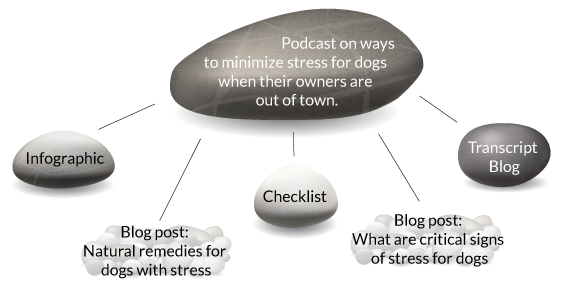
How to Build a Content Marketing Plan and Calendar for My Department
March 16, 2017

Anyone involved in inbound marketing knows that it is only possible with content. Some have called content the “lifeblood of inbound marketing” and stated simply that “there is no inbound without content.”
Thus, building a content marketing plan and calendar is core to your efforts and must be a department priority on a regularly occurring timeframe. Depending on your organization, this timeframe might be yearly, quarterly, or even monthly. The timeframe is not so important as is that it happens consistently, without fail.
Note: This post assumes that you have already created buyer personas. If you haven’t completed this fundamental task yet, do it now. Check out this post on developing buyer personas from scratch. This post also assumes you’ve determined your goals for your content marketing and that they are SMART!
Okay, here we go:

Step 1) Do Your Research
Developing your content calendar must start with research to find out what will be interesting and valuable to your personas. In a blog post last September, I recommended some of the following research questions:
- What is your industry currently buzzing about? What is “hot” right now?
- Ask customers: What general topic would they find valuable if they weren’t a customer yet?
- What are your competitors talking about?
- What trends are appearing in your social media feeds?
- Ask your sales team: Has any industry news been popping up in conversations?
- What pain points did you identify for your buyer personas?
Calendar Tools
The nine-step process outlined in this post demonstrates how to build a content plan from scratch conceptually. In terms of calendar tools, there are many out there; Curata has a fantastic list on its blog: “Content Marketing Editorial Calendar Templates: The Ultimate List.”
In addition to the above, you may want to conduct some keyword research to determine where there is opportunity, i.e., little content exists on that topic versus ones that are oversaturated.
In September, my colleague Hansen Hunt outlined how to use Quora, Moz, and AnswerThePublic to find questions your audience is asking; this is another great place to spend some time conducting research!
Step 2) Brainstorm
Once your research is complete, it’s time to brainstorm with the team. This step is where you take all of the research you conducted and expand on any content idea the team has. Depending on your team, it might make sense to include a salesperson or two (if they “get” inbound marketing), a product person, a tech support employee, even a C-suite leader if he or she has a regular interest in the content your company is creating and/or interacts with customers or prospects.
Personally, I prefer a whiteboard approach (a company that I worked at several years ago painted two walls in the conference room with whiteboard paint), but anything will work to facilitate brainstorming: sticky notes, laptop with a projector and note taker, big notepads, whatever.
As you brainstorm, three things to keep in mind:
- This is the time to expand your list—no idea is off limits. Don’t shut someone down if their idea sucks. Let the good brainstorming juices flow.
- As your team throws out ideas, keep in mind that you’ll (eventually) want content for all of your buyer personas in each stage of the Buyer’s Journey. So if every topic is an awareness e-book for Marketing Mary, you’ll be limited later.
- Brainstorm both topics and content format, such as webinars, podcasts, slideshares, e-books, and so on. An awesome list of formats is here on HubSpot’s blog.
Step 3) Define Your ‘Rocks’ and Themes
I remember when I first heard the Rocks Pebbles Sand story; I was in high school during an all-school assembly. It stuck with me, perhaps because it’s such a visual lesson.
If you’ve never heard the story, check out:
Whereas in the story the rocks are the important things in life, for inbound marketing the rocks are going to be our big pieces of content.
 About a year ago, I introduced a fictional dog-sitting business. For this business, your content marketing rocks for this quarter might be:
About a year ago, I introduced a fictional dog-sitting business. For this business, your content marketing rocks for this quarter might be:
- A podcast on ways to minimize stress for dogs when their owners are out of town
- An e-book on the pros and cons of leaving pets with a business who specializes in dog-sitting
- An in-person event at a local pet store giving away a free afternoon of dog-sitting
The number of rocks that are right for your organization will depend most heavily on your goals for the time period, the resources you have available, and your budget.
As you place these rocks into your jar, remember your Buyer Persona / Buyer’s Journey (BP/BJ) matrix and make sure you have “something for everyone.” In our example, this might look like:
|
Awareness |
Consideration |
Decision |
|
|
Stay-at-Home Mom Sally |
Podcast on ways to minimize stress for dogs when their owners are out of town. |
E-book on the pros and cons of leaving pets with a business who specializes in dog-sitting. |
In-person event at a local pet store giving away a free afternoon of dog-sitting. |
|
Working Professional Walter |
[Existing offer: E-book on when a dog exhibits destructive behavior while owner is at work.] |
[TBD] |
In-person event at a local pet store giving away a free afternoon of dog-sitting. |
Some boxes might be filled in during future timeframes; some boxes might have content from previous timeframes.
For some organizations, especially those that already have a lot of content, it might make sense to identify a theme for that time period and then create offers around that theme in the BP/BJ matrix.
Step 4) Pencil in Your Turkey Slices
Back in January of last year, I relayed one of my favorite analogies ever:
At INBOUND 2014, I heard Jason Miller, Global Content Marketing Leader at LinkedIn, give a fantastic analogy of this concept featuring Thanksgiving dinner and turkey slices. In a blog post on the topic, Jason describes interviewing Rebecca Lieb, author of Content Marketing, and asking for her number one tip regarding creating content. She replied: “I use a Thanksgiving analogy. You cook up this giant bird to serve up on one glorious occasion and then proceed to slice and dice this thing for weeks on end. If you are like most families you are going to be repurposing this bird as leftovers for quite some time creating everything from sandwiches, to soups, and more. Your content marketing strategy can be thought of in the same way.”
Though I’m hoping not to mix metaphors too much, I couldn’t resist sharing this again. Once the rocks (or Thanksgiving turkey) for our timeframe are set, we are ready to start thinking about how we can reuse that content in different ways (turkey slices) to create the pebbles that will surround those rocks.

Perhaps the content of a webinar can be repurposed into an infographic and a checklist. Perhaps that podcast can be transcribed and added to the blog. Perhaps images from the e-book can be reworked with key takeaways to share on social media.
Think about it this way: How can we get the most use out of this content as possible?
Step 5) Fill ’er Up
Now that your rocks and pebbles are defined, it’s time to fill the jar with sand. In terms of your calendar, this means making sure that you have a full schedule of blog posts to complement your major initiatives.
Depending again on resources, your organization may start with one blog per week (the minimum we recommend) before working your way up to 3-4 per week. The main thing for blog posts is consistency—show your readers (and Google) that you have fresh content regularly and you’ll be rewarded.
Going back to our example:

You may have done some keyword research in the beginning, but now is the time to nail down which keywords you want to target and how they fit into the theme and blog posts.
Fill any gaps with the remaining things you want to cover this quarter, and you are now ready to move on to step 6.
Note: Titles of your assets and blog posts don’t necessarily have to be finalized at this point; they can be refined and tweaked as you get closer to publication. However, it may be helpful to write a couple of bullet points for each content piece so that you can capture your thoughts now versus starting from scratch when you go to write the post or offer later. This is also a great idea when you have several blog post titles that are similar; it will allow you to distinguish how one blog is different than another.
Step 6) Step Back for a 10,000-Foot View
Because you were just down at the granular level, it’s possible to get sidetracked into the weeds. Sleep on it. Take a day and marinate on the themes and your rocks.
Then step back and take it all in. Is your calendar missing something? Do the pieces fit together the way you initially thought? Don’t start the whole process over, but make sure to take a moment to assess from that 10,000-foot view.
Step 7) Buy-In
All organizations have a different process for content calendar approval, often depending on the size of the company. In some cases, the Director of Marketing must get sign-off from the CEO. In other cases, the VP of Marketing has complete control to approve the calendar and move forward.
In any case, getting buy-in with key stakeholders at your company should never be optional. Spending as few as 10 minutes with each person to go over the theme, objectives, and even the inbound process may save you many headaches in the long run when it comes to product managers reviewing content, salespeople following up with whitepaper downloads, and overall engagement with employees and the marketing department.
Step 8) Implement!
The greatest plan on earth is worth nothing unless you implement it. It's go time!
To facilitate implementing your content, a project management tool will be your best friend. Internally at SmartBug, we use Teamwork, but there are many options out there, including Basecamp, Trello, and more. A project management tool will take your plan and turn it into reality.
HubSpot implemented a calendar tool into the software in 2014 with which marketers can schedule things in advance, assign tasks to team members, and see what’s going on at a glance. It may be worth checking out for your organization, especially if your team lives and breathes in HubSpot.
Check out my blog post on 7 Time Saving Tips When Implementing a Content Marketing Plan »
Step 9) Measure, Rinse, Repeat
When launching a content marketing plan from scratch, you will have nothing to compare against. However, once your program gets going, you’ll soon have all sorts of data. Make sure that you evaluate and assess the performance of your rocks as well as the supporting pieces against your goal.
Armed with data, you can make informed decisions as you dig back into research and begin the process all over again.
---
Let me end with a word of advice about creating a content marketing plan and calendar. Drafting a plan and calendar is absolutely crucial to staying on track. According to Joe Pulizzi from the Content Marketing Institute: “One thing is certain: if you don’t keep an editorial/content calendar, the content doesn’t get done.”
However, most marketers can tell you that rigidly adhering to a content calendar just isn’t going to happen in their organization for whatever reason—delays in subject matter experts writing content, delays in approvals, delays due to a major tradeshow, and on.
So to maintain your sanity, develop a calendar, but foster a sense of flexibility within the department. Have a couple of blog posts on the backburner that can be pulled when there’s a delay. Swap one offer with another when priorities change. Go with the flow while communicating your goals and how your content marketing plan ties back to those goals.
(P.S. Another great resource on the topic of creating a content marketing calendar is by Nathan Ellering on the CoSchedule blog: “How To Plan A Marketing Calendar That Actually Works.”)

About the author
Jessica Vionas-Singer was formerly the Senior Director of Client Success at SmartBug Media where she lead a team of SmartBugs who focus on HubSpot onboarding for clients new to the system and other project-based work, oversaw new employee onboarding, and rolled out new process and procedures within the Client Services department. She fell in love with marketing at her first job at a technology company specializing in credit evaluation software. Her background includes more than 20 years of marketing experience in content creation and lead-driving tactics, online presence and blog creation, social media engagement, budgeting and project plans, webinar and trade show event management, public relations, comprehensive promotional campaigns, and analytics. Jessica has a BS in Sociology from Montana State University – Bozeman. Read more articles by Jessica Vionas-Singer.







